Since their unanimous endorsement by the UN Human Rights Council ten years ago, the UN Guiding Principles have been simultaneously lauded for their impact, underestimated by critics and limited by misunderstanding. What is often missed in such analyses is the inherent radicalism of the UNGPs. This revolution in our expectations of the role of business in an increasingly unequal globalized economy has been reflected in norms of behavior, law and practice. It is worth returning to that quiet radicalism as we take stock of successes and look to the potential to drive further change over the next decade of post-pandemic recovery and beyond.
PROGRESS
Too infrequently do we cast our minds back to the world of corporate accountability prior to the UNGPs, when the absence of an agreed standard of conduct meant endless (and often futile) dialogue to secure acknowledgement that a business had any responsibility in relation to a human rights impact. Without a cross-cutting expectation of business behavior, every issue and incident was subject to relitigation of what standards were relevant and arguments over what action was “reasonable.” The mere existence of a single, accepted standard of conduct allows a shared understanding of responsibility and a starting point for accountability.
The mere existence of a single, accepted standard of conduct allows a shared understanding of responsibility and a starting point for accountability.
Transforming a business to focus on risks to people’s human rights and not just risks to the business, remains arguably the single most radical idea within the Guiding Principles; yet it is still the hardest thing for businesses to embrace to its full extent. Standard practices such as prioritizing action within the company’s own operations, focusing supply chain risk management on branded products, and cutting relationships with business partners shown to have bad practices, all flowed from the notion that the ultimate responsibility of a company was to protect the business. Introducing the lens of risks to people into decision-making highlighted a need to rewire swathes of processes, scrutinize core business models and strategy, build empathetic leadership and more open and reflective corporate cultures.
Critical to operationalize that focus on risks to people is a willingness to listen to those people with the least power to influence, and the most to lose from, the impacts of business activity. While the term “engaging affected stakeholders” may sound anodyne, the intent is no less than to drive empathy for the disenfranchised to the heart of the company. The humanization of those in precarious situations – viewing them not as economic units, but as individuals the equal of executives – ought not to have been such a profound departure for business decision-makers. That said, we already see a growing number of companies deploying approaches from Global Framework Agreements, to worker voice tools, to joint fact-finding missions and dialogue tables, as ways to harness the perspectives of people who are distanced from company boardrooms. This focus on the interests of affected stakeholders, rather than those who have most influence, offers the key for the emergent concept of stakeholder capitalism to be more than a shift in rhetoric.
The UNGPs expect companies to look for risks to people across their entire value chain while recognizing differentiated responsibilities for where they cause or contribute to an impact, or where the impact is directly linked to their operations, products or services. This combination of a wide scope with nuanced implications for action, provides the incentive structure for businesses to dig into issues deeply embedded in their supply chains where the harms may be most severe. A company’s “control” over human rights risks and outcomes no longer drives the logic for action. In situations beyond its sole control, companies are challenged to build and use their leverage to change the behavior of others. This pushes companies beyond compliance thinking, necessitating creativity and innovative partnerships, and attention to the root cause of the problem. Today’s reality of companies collaborating on issues such as gender-based violence, child labor and living wages that are intertwined with social norms, power structures and hierarchies shows the folly of seeing the UNGPs as a “do no harm” framework.
Today’s reality of companies collaborating on issues such as gender-based violence, child labor and living wages that are intertwined with social norms, power structures and hierarchies shows the folly of seeing the UNGPs as a “do no harm” framework.
At the same time, the UNGPs have required companies to address their own contribution to these impacts, rather than seeing them as the “fault” of others. This brings penetrating questions of business model, product/service design and purchasing practices into any evaluation of a company’s involvement with impacts far down the value chain. While many businesses still struggle to address their own contribution, some of the most interesting initiatives at play are those that attempt to focus on contribution at an industry level while harnessing the collective leverage of those involved to influence external actors at the same time.
untapped potential
When the radicalism of the UNGPs has not been fully understood, sub-par implementation has followed. There is huge untapped potential to drive change for those that need it most if businesses can grasp the full implications of their responsibility.
Too often we hear that businesses “have done their due diligence” when in reality they have simply assessed risks, sometimes ineffectively, and frequently without engaging those at risk of negative impact. This approach is typically seen in a traditional social audit model that monitors performance and expects conditions to improve. At the heart of this ineffectual risk assessment is a focus on business risk – with some companies wanting to retain the comfort blanket of pointing to activity, rather than effective action, in the event of reputational damage. From time to time, this type of approach may lead to the removal of certain suppliers (and indeed there may be calls from various quarters to do so). But human rights due diligence is not just about assessment and nor is it about de-risking value chains. We need to see more businesses decide not just to cut suppliers, but to genuinely engage with the greater complexity of addressing the problem.
An associated challenge in implementation of the UNGPs has been the reduction of “leverage” to contractual or commercial clout. But effective leverage requires a root cause analysis of a human rights impact to work out who needs influencing and involves a great deal of creativity in coming up with different approaches to that end. In fact, the best form of leverage in some instances may well be to advocate towards governments to make sure that they have the right laws and policy framework in place to protect people. The reason that some companies have started to use their leverage in this way is in recognition that many human rights issues are systemic and can’t be dealt with by individual companies trying to root out the problem in their specific supply chains.
Recognizing an impact as systemic and structural does not diminish a company’s responsibility to prevent and address their role in these impacts. #MeToo, the Black Lives Matter movement and ongoing campaigns for LGBTQI people have underlined the structural discrimination that millions continue to face globally. But the business and human rights community has been slow to join the dots between these events and the corporate responsibility to respect human rights. The UNGPs should in fact lead companies to assess their connections to underlying structural discrimination, to articulate these and the company’s alignment with broader goals to tackle the root causes of racism, sexism and trans- and homophobia, amongst other forms of discrimination.
Once we recognize the company’s responsibility to address connections to contextual risks and structural issues of this kind – and that advocacy, voice and influence can be a legitimate and necessary route to exercise leverage – it stands to reason that businesses should consider taking this sort of action, pre-emptively. To take the example of human rights defenders, if companies do not conduct an early analysis of the political situation where they operate, source or sell and seek to stymie any encroachment on broader civic freedoms – they are only ever likely to be on the back foot when a human rights defender connected to the business is attacked or threatened. This logic applies more broadly to high-risk contexts where state actors may be the source of human rights risks. Companies must seek to not only assess the risk of market entry, but to build future leverage pathways in the event that the worst-case scenario transpires.
But what this can’t mean is an expectation on companies to take pre-emptive action on all social issues, everywhere, all the time. There must be a connection to the business, its products or services. Not to apply such rigor would dissolve the consensus behind the expected standard of conduct and obstruct attempts to hold companies accountable for their actions against that framework.
That the full potential of the UNGPs has not yet been unleashed, certainly makes the case for emerging regulations to scale quality human rights due diligence and demand serious implementation of the UNGPs rather than partial actions that do them lip-service. That must include more proactive and deliberate actions on remedy from companies – another area where the potential of the UNGPs has not been reflected in practice. Effective implementation of the UNGPs has to be underpinned by the embedding of human rights into boardroom discussions, leadership action and organizational culture. These areas will be priorities for Shift as we continue to work with all stakeholders to help realize a world in which business gets done with respect for people’s rights.
But the Guiding Principles will not cease to be relevant when remedy is provided as a matter of course, when investors are using precise human rights data to rewire capital markets, or when mandatory measures allow for companies to be held legally liable for serious harms to people’s human rights. By their very nature as “guiding principles” they have the flexibility to be relevant to new realities. As respect for human rights is based on an assessment of “reasonableness,” the actions that are expected to meet the standard will always evolve: as leading practice develops and crystallizes, these practices become a baseline expectation of all.
The UNGPs will continue to adapt to future challenges, stretch ambition, and ultimately provide a framework for us to understand the role of business in our complex, post-pandemic world. This is the quiet radicalism of the UNGPs.
As such, the UNGPs will continue to adapt to future challenges, stretch ambition, and ultimately provide a framework for us to understand the role of business in our complex, post-pandemic world. This is the quiet radicalism of the UNGPs.

 By Francis West
By Francis West



